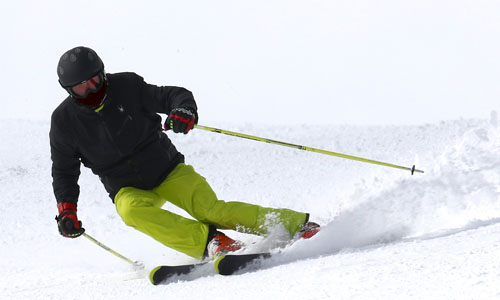The Evolution of Skiing
Author

Chris shares his passion for cycling, hiking, skiing, and climbing from Buxton, in the Peak District. As a blogger for Outdoor Look, Chris shares outdoor tips and indoor tricks to help you get the most out of your time spent outside. When he's not out adventuring he's making videos or trying to keep up with his 4-year-old son.
 Modern skis are the product of cutting-edge technology allowing manufacturers to design and refine their equipment with sub-millimetre accuracy, ensuring that your skiing experience is as smooth and as ergonomic as possible. But it wasn't always that way! Today, I'm taking a look back at how the development of skiing equipment has changed over the years and what effects this has had on the sport of skiing itself.
Modern skis are the product of cutting-edge technology allowing manufacturers to design and refine their equipment with sub-millimetre accuracy, ensuring that your skiing experience is as smooth and as ergonomic as possible. But it wasn't always that way! Today, I'm taking a look back at how the development of skiing equipment has changed over the years and what effects this has had on the sport of skiing itself.
Skiis really have undergone a world of change since the early days, with new materials, new manufacturing techniques and even new shapes having contributed to a complete transformation in the way that we descend down the slope. This may be hard to believe, but the first skis appear to have been invented more than 10,000 years ago in China, where cave drawings depict ancient hunters navigating the landscape on primitive skis. Other snowbound societies in places such as Russia and Scandinavia were similarly early adopters of this new technology.
The 1800s and the invention of wooden skis
The cambered ski was developed by woodcarvers in Telemark, Norway. The bow-shape cambered ski arched up towards the center to evenly balance the weight of the skier across the length and breadth of the ski. This thinner, lighter ski ran faster and maneuvered with better agility than more primitive skis.
Sondre Norheim of Norway first demonstrated the Telemark ski, having a side cut that narrowed the ski underfoot while the tip and tail remained wider. In the same way as the camber, the sidecut produced a ski that flexed more easily when tipped on edge, so that in a turn its edge followed the shape of the turn and didn’t skid sideways.
Most high-quality European skis were made of strong, springy ash. In 1882, the first hickory skis were produced in Norway. Hickory was so hard and tough that it was difficult to work with traditional hand tools. But with modern carbon-steel tools, Norwegian ski makers began turning out hickory skis. The tough wood made it possible to build a thinner, extremely flexible ski with good strength, and the hard base was less likely to gouge and scar enough to slow the ski down or cause it to sideslip during a downhill run.
 The 1920s and beyond: Innovation and improvisation
The 1920s and beyond: Innovation and improvisation
The segmented steel edge, invented by part-time mountaineer Rudolph Lettner of Austria in 1926, enabled better grip on hard snow while still allowing the wood to flex naturally. However, edge segments could break in two. In that case, it was usually difficult or impossible to continue skiing. Skiers usually carried spare edge segments, along with a screwdriver, screws and glue, to make field repairs. Then, in 1928, Swiss ski racer Guido Reuge invented the Kandahar binding, using a spring-loaded cable to hold the heel down for alpine skiing.
Innovation and experimentation continued throughout the 1930s. In 1932, the first successful three-layer laminated skis were invented by Bjørn Ullevoldsaeter of Norway. These skis were made using waterproof casein glues, did not delaminate easily and lasted much longer.
The 1940s and beyond: The introduction of Redux Glue and the fiberglass
Then, in 1945, the Vought-Sikorsky aircraft company used Redux glue to create Metalite, an amalgamation of aluminum with a plywood core. The company used the process to build an aluminum-laminate ski with a wood core. A thousand pairs of the Truflex ski were made but when aircraft production picked up, the company dropped the project and did not release the patent.
It was not until 1952 that the first fiberglass-reinforced plastic ski, the Bud Phillips Ski, was not satisfactory enough to endure the pressure. The first successful plastic fiberglass ski was invented by Fred Langendorf and Art Molnar, in Montreal, and marketed under the Toni Sailer label in 1959.
1960s to 1990s: Innovations galore
Steady improvements in the quality of plastic materials enabled efficient construction of skis, but these were very expensive. Manufacturers mixed small quantities of Kevlar, carbon fiber, ceramic fiber, and other high-strength materials into fiberglass to help improve strength, resilience, damping, and torsion.
Then in 1989, Volant Skis, the first commercially manufactured steel ski, introduced by Bucky Kashiwa was introduced. But, their factories were closed-down in 2001 due to high labor costs and production now moved to Austria. Some of the Volant production equipment were bought by David Goode, who used it to produce a ski made largely of carbon fiber.
Today, we have skis that are manufactured using the latest high-tech techniques, but it's amazing to think of how passionate people must have been to continue enthusiastically skiing over a hundred years ago, even when their equipment was not really up to scratch.
Author

Chris shares his passion for cycling, hiking, skiing, and climbing from Buxton, in the Peak District. As a blogger for Outdoor Look, Chris shares outdoor tips and indoor tricks to help you get the most out of your time spent outside. When he's not out adventuring he's making videos or trying to keep up with his 4-year-old son.
- Speed Up Your Post-Hike Recovery with These 6 Essential Tips
- Cycling through Tranquil Roads and Coastal Views on the Isle of Wight
- The Essential Guide to Hiking Safety: 5 Tips Every Hiker Should Know
- Run Smart, Run Strong: Your Guide to Injury-Free Running
- Embrace Biking: Essential Tips for Beginners
Categories
- Sport (28)
- Product Reviews (3)
- Team Outdoor Look (7)
- Mike Wild (2)
- Mike Payton (2)
- Suse Hammond-Pears (3)
- Snowboarding (12)
- Latest Offers (105)
- Shop Talk (1)
- Competitions (7)
- Walking (413)
- Lifestyle Fashion (8)
- Travel (86)
- Kit Guides (176)
- Workwear Clothing (6)
- Safety Workwear (4)
- Health/Fitness (289)
- Skiing (91)
- Great Outdoors (1316)
- Cycling (92)
- January 2025
- December 2024
- November 2024
- October 2024
- September 2024
- August 2024
- July 2024
- June 2024
- May 2024
- April 2024
- March 2024
- February 2024
- January 2024
- December 2023
- November 2023
- October 2023
- September 2023
- August 2023
- July 2023
- June 2023
- May 2023
- April 2023
- March 2023
- February 2023
- January 2023
- December 2022
- November 2022
- October 2022
- September 2022
- August 2022
- July 2022
- June 2022
- May 2022
- April 2022
- March 2022
- February 2022
- January 2022
- December 2021
- November 2021
- October 2021
- September 2021
- August 2021
- July 2021
- June 2021
- May 2021
- April 2021
- March 2021
- February 2021
- January 2021
- December 2020
- November 2020
- October 2020
- September 2020
- August 2020
- July 2020
- June 2020
- May 2020
- April 2020
- March 2020
- February 2020
- January 2020
- December 2019
- November 2019
- October 2019
- September 2019
- August 2019
- July 2019
- June 2019
- May 2019
- April 2019
- March 2019
- February 2019
- January 2019
- December 2018
- November 2018
- October 2018
- September 2018
- August 2018
- July 2018
- June 2018
- May 2018
- April 2018
- March 2018
- February 2018
- January 2018
- December 2017
- November 2017
- October 2017
- September 2017
- August 2017
- July 2017
- June 2017
- May 2017
- April 2017
- March 2017
- February 2017
- January 2017
- December 2016
- November 2016
- October 2016
- September 2016
- August 2016
- July 2016
- June 2016
- May 2016
- April 2016
- March 2016
- February 2016
- January 2016
- December 2015
- November 2015
- October 2015
- September 2015
- August 2015
- July 2015
- June 2015
- May 2015
- April 2015
- March 2015
- February 2015
- January 2015
- December 2014
- November 2014
- October 2014
- September 2014
- August 2014
- July 2014
- June 2014
- May 2014
- April 2014
- March 2014
- February 2014
- January 2014
- December 2013
- November 2013
- October 2013
- September 2013
- August 2013
- July 2013
- June 2013
- May 2013
- April 2013
- March 2013
- February 2013
- January 2013
- December 2012
- November 2012
- October 2012
- September 2012
- August 2012
- July 2012
- June 2012
- May 2012
- April 2012
- March 2012
- February 2012
- January 2012
- December 2011
- November 2011
- October 2011
- September 2011
- August 2011
- May 2010
- April 2010
- March 2010
- February 2010
- January 2010
- November 2009
- October 2009
- September 2009
Submit a Comment